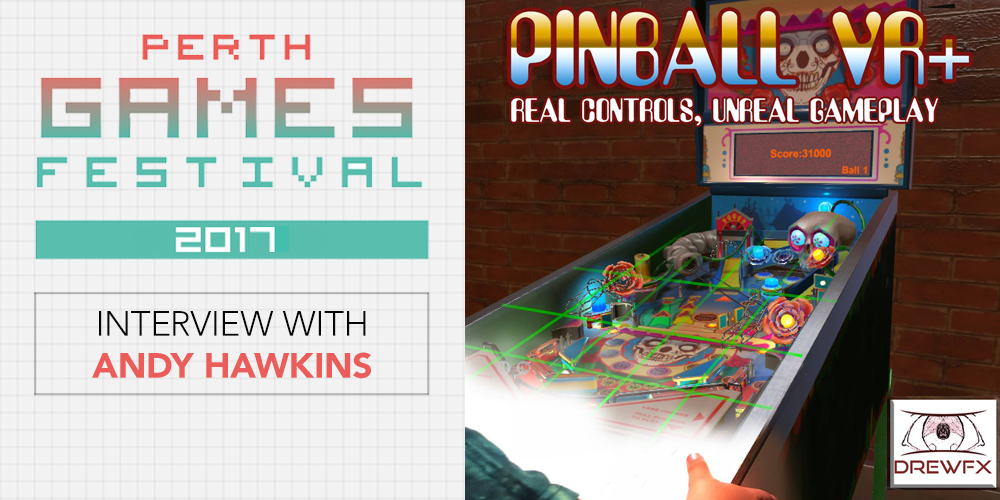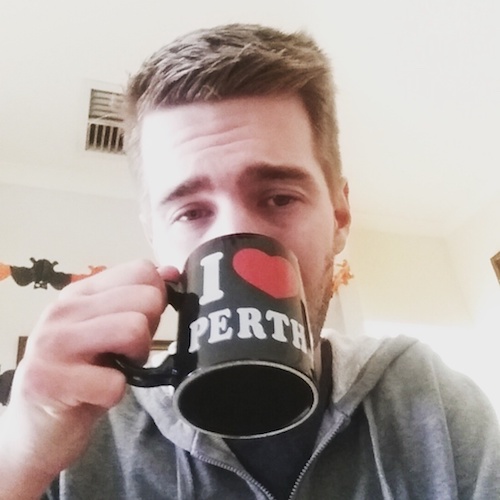
While VR has arguably dropped from the limelight a little in recent months, experimentation and progression of the concept are still very much in full swing. Andy Hawkins, game design TAFE lecturer by day and indie developer by night (or something like that), has been at the forefront of the world of VR with his studio, DrewFX, and proved at this PGF that exciting things are still happening in the field.
His creation, Pinball VR+, involves a small portion of what you’d expect on a real vanilla pinball machine (in this case, all necessary triggers, plunger, buttons etc. needed to play) while the rest lives in the world of VR. Based on a creator studio, virtual pinball tables have been adapted with the HTC Vive in mind. I’m certainly no pinball aficionado, but I found the setup immersive and considerably satisfying to play. Anything VR is instantly cool, but the fact that I could hold and operate (what feels like) a real pinball machine at the same time with this setup, added a huge degree of coolness I’ve never experienced in a pinball video game.
I caught up with Andy at PGF 2017, and we discussed Pinball VR+, his studio, his experience in the industry as well as the TAFE courses he’s a lecturer for.
Can you take us through developing the concept?
There’s a whole bunch of people online that are doing this kind of thing – that is, making only a fragment of the pinball machine and then the rest in VR. It came from a very popular IP called Pinball FX 2, and that’s when the guy [developer of the pinball creator kit] started doing it. I just copied what they did, and I came up with my own console that you hold onto and started building my own pinball as part of my TAFE lecturing job.
I wanted the kids to get into pinball really quickly by rapidly prototyping a table, but I thought it may have been a bit hard for them to build it all from scratch. So, I found this pinball creator kit, and that’s what you’re seeing here. I contacted the guy, and I basically said, look, we want this for the students, so can I completely script it and customise it? He said, yeah, do whatever you need to do (which was great), and he gave me a free copy. I was already doing this for the Perth Games Festival anyway, and I wanted it for the home, but it was a toss-up between the half cabinet virtual pinball game – or, what you can normally do is get a 43” LCD TV and lay it down flat, and then have a monitor at the end where you add an Xbox Kinect which tracks your head. That sounded to me like way more hard work and lots more gear and money, so I went for the easier option. It’s also fun to play, so that’s how it came about.
On the software side of things, the actual gameplay is developed in Unity. Have you made that mostly from scratch or is it using the pinball creator kit?
It’s using his tables, but what I did was download the Steam VR STK plugins for Unity and (in consultation with the creator) turned off his dynamic camera control system, and then dropped in the Steam VR camera system. I’ve then performed a few tweaks so that my console (that has an encoder in it) can read the button pushes, like the insert 20c and launch ball controls. It comes across the computer as key presses, so I’ve had to go back through the software and remap those.

Tell us a bit about the hardware in the console. Is that an Arduino?
It’s something like an Arduino – it’s a custom-made board by the guy who makes the plunger, which itself is just running on a sliding potentiometer. That potentiometer goes to the board, which then tells the computer that an Xbox controller is plugged in (specifically, the right joystick) which Unity can recognise.
There’s an accelerometer chip in there as well so you can tilt it. But since I’ve put the wrong legs on the table [attached to the console], and it’s so unstable, people are going to wack this around, which meant I couldn’t get complete control over the values, so I’ve disabled that part.
The rest of it is standard arcade mapping. When I press these buttons, it recognises it as the left and right shift keys. This is really easy to do if you’ve done it before – I built the cabinet myself.
Where did you source the parts from?
OzStick – they’re over in Melbourne. But apparently there’s a store in South Perth who have parts too, so I’ll have to check that out.
Is there going to be any larger release of this console? Or is it largely an educational tool?
I think the Pinball game would go down well as a stand-alone kit. Like if you saw it in Kmart, a “build you own pinball VR machine” – people would love to buy that. But the price of computers and VR headsets right now are prohibitive to implement such an idea. Perhaps in the future, with the dropping prices of mixed reality headsets, this might be a more affordable idea over time.
I’d buy that! Can you tell us a bit about DrewFX?
DrewFX has been running since 1997. My first game was Starfighter D’Yammen’s Reign, and then after that, I worked with a bunch of guys on two Game Boy Advance games – one was called Arcade Games and the other Card Games.
During the app boom, I wrote Turbo Flick Demon GPU and Surf Prodigy. I’m rebooting those. The ultimate DrewFX product I want to bring to PGF is VR Surfing. I’m still working on that type of stuff, and that’s the progression: I’ve done a surfing game, and I’ve done VR. That will be putting the two together, and I think it would be really good.
For a while, DrewFX was dormant because I was working on commercial VR apps, but I found that the industry isn’t quite ready to take it up yet, so I’ve gone back into video games. Everything I’m learning through DrewFX, I give back to the TAFE job I have.

Did you have any game development experience before DrewFX?
When I was a kid I bought a Dick Smith VZ200, so I started when I was really young – at 11 or 12 I was building games, and that’s where it stemmed from. Eventually, I got an Amstrad and then an Amiga – I seemed to pick the wrong computers every time! Finally, I got an IBM and built it up from there.
Can you tell us a bit about the TAFE course?
The TAFE course is called Animation and Games Design. We’ve got a certificate 3 and 4 with start of the year and mid-year entries. Those lead to a diploma in Animation and Games where students get to dabble in 3D, video, computer games, audio and 2D animation. After that, they branch off and they pick either the Advanced Diploma of Games Development or the Advanced Diploma of Animation.
And then to cap it all off there’s what’s called Studio Production Development – which is a return to TAFE course. Anyone can do this, so if you want to get in touch with me and have an idea for a project but you haven’t got the money to try it out, you can do a certificate called Realise Production for $220 for the entire year. You basically got free office space and free software licences to test the waters.
Are there any other projects in the works?
I was going to reboot Turbo Flick and Surf Prodigy since they’re no longer in the app store, but what I’m going to do instead is a 3D shooter called Last Moon. There’s an old game by Williams called Blaster which a mate and I were playing. We liked the idea of voxels plus the idea of rebooting this into VR and 3D – so that’s going to be one game.
The other one I really want to do is the Surfing VR game (mentioned above), but the thing I’m mainly working on at the moment is converting Turbo Flick from a mobile phone game into an immersive VR game called Turbo Flick Demon GPU VR Plus. So, you’re down there on the grid, kind of like Tron (but my own version of it), called Nanotek. You have a massive blaster gun that you ride with (it has a thruster on it as well) that at the same time can fire massive pinballs.
If you’d like to keep up with the games being developed by Andy Hawkins at DrewFX, check out the following:
Website: http://www.drewfx.com
Facebook: https://www.facebook.com/drewfx/











